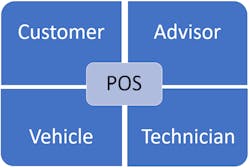This MTD exclusive was provided by Dennis McCarron, a partner at Cardinal Brokers, one of the leading brokers in the tire and automotive industry. Dennis also writes MTD's monthly Business Insight column.
If you get 30 tire dealers in a room and bring up point-of-sale (POS) systems, prepare for 45 different opinions and a very long, passionate conversation.
This month’s column is not going to endorse any particular POS system. Instead, it will help you learn to drive your POS system like the race car that it is and understand what role it plays at your dealership.
As a consultant, when I go to on-site visits, one of the first things I check is the life cycle of the ticket. How does everyone build an initial ticket? How do items get added onto the invoice? Are packages used? How do items get noted for customer attention and/or sales? How do additional sales get approved? How does a ticket close out?
This is like the race track of a ticket. You drive from one point to the next, answering these questions. If you skip a question or don’t follow the track, you will get lost.
Not all POS systems can do everything great or answer every question. As a matter of fact, no POS does everything great. But you can’t take a Lamborghini rock climbing, either.
Tire dealers need to learn more about their own POS systems and in many cases, learn the track better.
Often, I find dealers who are angry that their “POS doesn’t do this or that.” But in reality, this is not the case.
The most common reason for POS dissatisfaction, in my experience, is a lack of education on how a particular POS system functions. Many times, the system is installed, there is a quick tutorial on how to build a ticket and how to look up customers and it’s over. That’s a lot of trial and error.
Understandably, owners are more focused on the integrity of their data during a switchover to a new POS system, which can be nerve-wracking, especially if there are hiccups. However, this isn’t a good enough reason not to become an absolute expert on your POS system, which is the most frequently used tool at your dealership.
You owe it to yourself to make your company’s POS system sing like a perfectly tuned engine from a reporting standpoint, with the ability to rev the rpms to redline when building out the proper back-end inventory structure, so frontline employees can estimate a job in seconds.
Race car drivers know their vehicles inside and out. If you’ve only spent a handful of hours learning about your POS system when you first had it installed, you should request more formal learning from the provider or a reputable third-party educator.
You wouldn’t tolerate a technician using an impact gun as a hammer or letting your store’s air compressor run at half strength. Your POS system is a tool designed to improve workflow in a specific manner, just as any other piece of equipment or tool that you buy.
Your POS system is a race car that performs many operations, but its most important function is documenting communication. Every ticket is at least a four-way communication model. At the top of this article is a representation of this interaction.
I use a hub-and-spoke model because communication can start at any point. A noise from the vehicle may compel a customer to go to your dealership. The customer talks to your service advisor, who talks to the technician, who then communicates with the vehicle and then relays that information back to the advisor, who shares it with the customer. The vehicle then communicates to the customer that the problem was solved.
There is a circular aspect to this communication, but central to it all is the hub, which is your POS system.
Your POS system documents all of this communication as information is inputted and visually shows where in the process that communication is. It documents problems, conditions, authorizations, proceed orders, stop orders and specifications.
Your POS system also indicates to the next person in the process where to go as quickly as possible. Failure to learn how to use it is like skipping pit stops during a race.
Your POS system should make life easier, not harder. Your time will be well-invested in learning to use this tool properly, instead of fumbling around in the dark guessing, then getting mad and switching to another POS system — only to be met with the same frustration, since the same problem exists. Most POS systems are capable of way more rpms than you are using.
Dennis McCarron is a partner at Cardinal Brokers, one of the leading brokers in the tire and automotive industry (www.cardinalbrokers.com). To contact McCarron, email him at [email protected].
About the Author

Dennis McCarron
Dennis McCarron is a partner at Cardinal Brokers Inc., one of the leading brokers in the tire and automotive industry (www.cardinalbrokers.com.) To contact McCarron, email him at [email protected].
